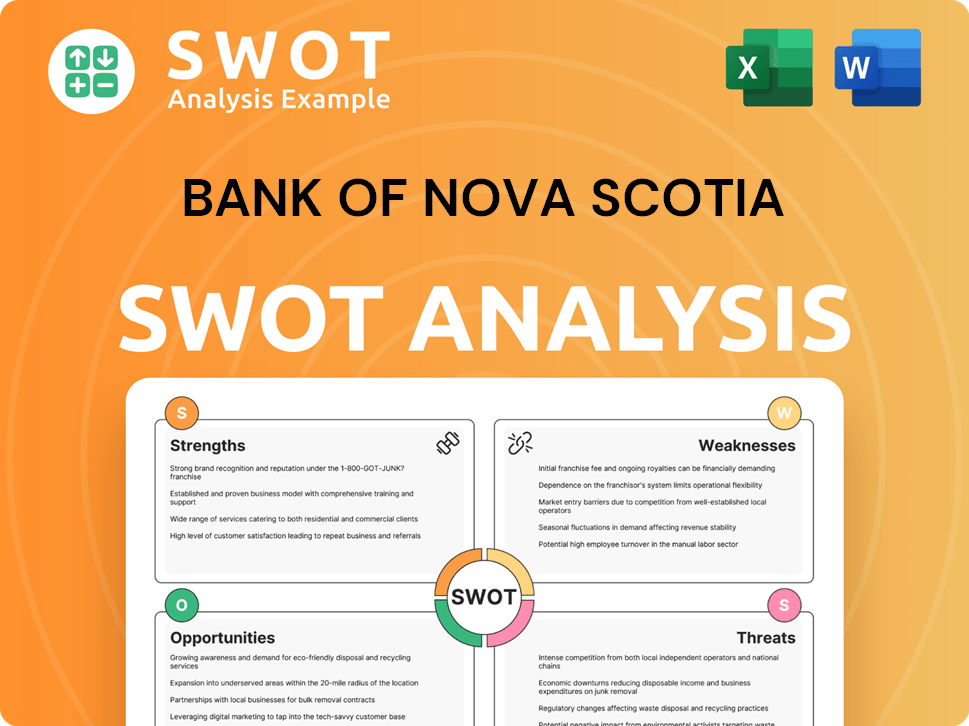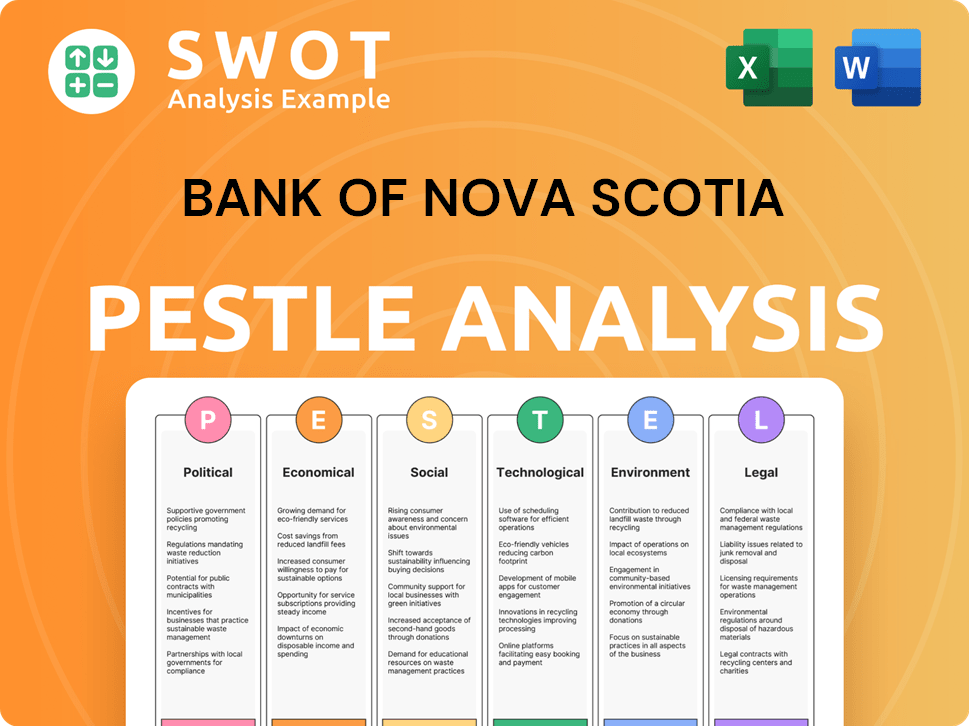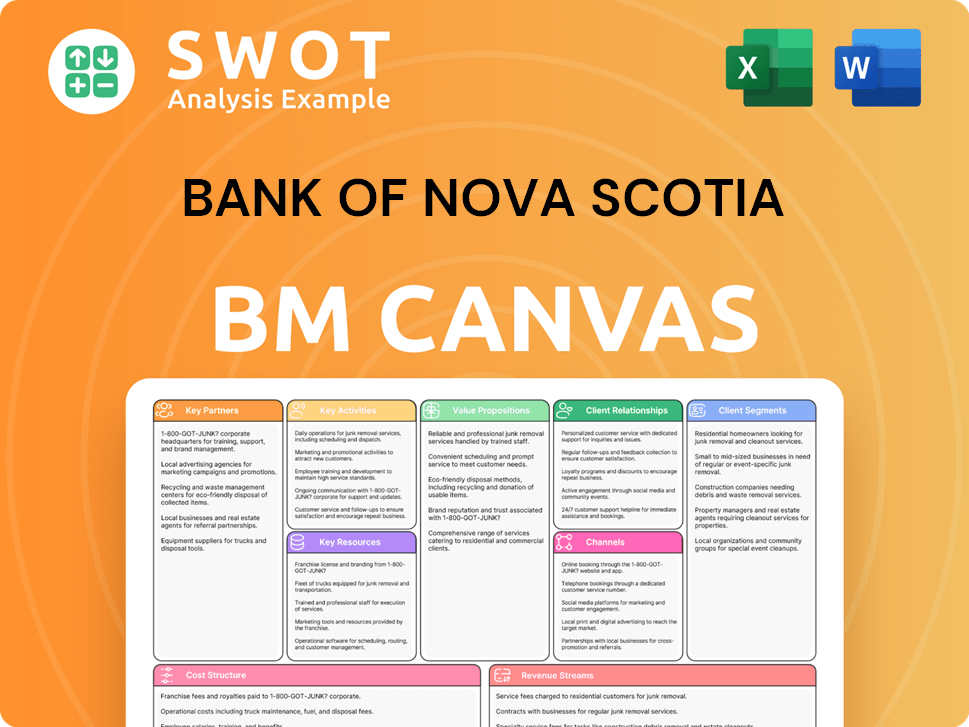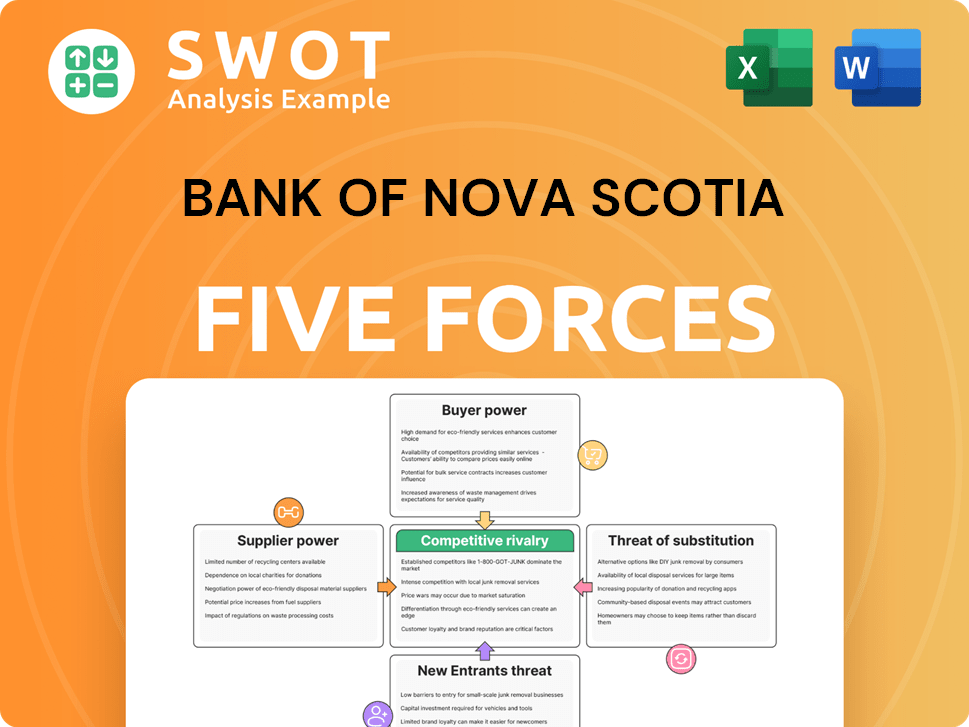Bank of Nova Scotia Bundle
Decoding Scotiabank's Customer Base: Who Are They?
In the ever-evolving financial landscape, understanding Bank of Nova Scotia SWOT Analysis is crucial for any financial institution aiming for sustained success. The dynamic nature of customer demographics and the strategic importance of identifying the target market are essential for a global financial institution like BNS. This deep dive explores the intricacies of Scotiabank's customer base, revealing how the bank strategically adapts to meet the diverse needs of its clientele.

This analysis will uncover the Bank of Nova Scotia customer profile, exploring its target market segments, including age, income levels, and geographic locations. We'll examine how BNS utilizes customer segmentation strategies to tailor its services, considering customer behavior and preferences. Furthermore, we'll investigate the bank's customer acquisition strategies and its approach to serving specific demographics, providing insights into its international target markets and customer lifetime value analysis. This comprehensive look at Bank of Nova Scotia's customer base offers a valuable understanding of how this financial institution navigates the complexities of the market.
Who Are Bank of Nova Scotia’s Main Customers?
Understanding the primary customer segments is crucial for analyzing the business strategy of a financial institution like the Bank of Nova Scotia. This involves examining the customer demographics and target market to grasp how the bank positions itself in the financial landscape. The bank serves a diverse clientele, including both consumers and businesses, each with specific needs and preferences.
The BNS focuses on various customer segments, from individual consumers to large corporations. The bank's customer base is diverse, encompassing various age groups and income levels. Analyzing these segments provides insights into the bank's market segmentation strategies and its approach to customer acquisition.
The BNS operates in both the Business-to-Consumer (B2C) and Business-to-Business (B2B) sectors. In the B2C segment, the bank targets a broad demographic, including young professionals and families, offering mortgages, investment products, and everyday banking solutions. For instance, the bank reported approximately 11.5 million customers in Canada as of Q1 2024. Affluent individuals are also a key segment, served through wealth management and private banking services. In the B2B segment, the bank supports small and medium-sized enterprises (SMEs) with commercial banking services and large corporations through its corporate and investment banking divisions.
The customer demographics for the BNS include a wide range of age groups, with a focus on young professionals and families. Income levels vary, with wealth management services catering to affluent individuals. Geographic targets include Canada, Latin America, and the Caribbean.
The target market includes consumers seeking mortgages, investments, and day-to-day banking services. SMEs and large corporations are also targeted through commercial and corporate banking services. The bank has expanded its international reach, focusing on emerging markets in Latin America and the Caribbean.
The bank employs market segmentation strategies to identify and target specific customer groups. This includes segmenting customers based on age, income, and geographic location. The bank also segments its market based on the needs of SMEs and large corporations.
The bank uses various customer acquisition strategies, including digital banking solutions to attract younger, tech-savvy customers. It also focuses on providing tailored services to different customer segments. The bank's international expansion is a key part of its customer acquisition strategy.
The BNS focuses on key customer segments, including young professionals, families, and affluent individuals in the B2C segment, and SMEs and large corporations in the B2B segment. The bank has expanded its international presence, particularly in Latin America and the Caribbean, serving 14 million customers as of Q1 2024.
- The bank uses market research to identify high-growth potential segments.
- Digital banking solutions are a focus for attracting younger, tech-savvy customers.
- The bank tailors its product offerings to meet the specific needs of each segment.
- International expansion is a key part of the bank's growth strategy.
Bank of Nova Scotia SWOT Analysis
- Complete SWOT Breakdown
- Fully Customizable
- Editable in Excel & Word
- Professional Formatting
- Investor-Ready Format

What Do Bank of Nova Scotia’s Customers Want?
Understanding the customer needs and preferences is crucial for any financial institution, and the Growth Strategy of Bank of Nova Scotia is no exception. This involves a deep dive into the customer demographics and target market to tailor services effectively. By analyzing customer behavior and preferences, the bank can enhance customer satisfaction and loyalty.
For individual customers, understanding their financial goals, such as saving for retirement or buying a home, is essential. Business clients require solutions for cash flow management and access to capital. These insights drive the development of targeted financial products and services.
Scotiabank addresses these needs by investing in digital platforms and offering personalized financial advice. This approach helps the bank meet the diverse needs of its customer base, from individual consumers to business clients, ensuring they receive the support and services they need to achieve their financial objectives.
Individual customers often prioritize competitive interest rates on mortgages and savings accounts. They also value convenient access to banking services through digital channels and reliable customer support. Psychological drivers include financial security and trusted financial advice.
The Scotiabank app saw a 3% year-over-year increase in active users in Q1 2024. Features like 'Smart Money' provide personalized spending insights, addressing customer desires for financial control.
Business clients need efficient cash flow management, access to capital, and specialized industry expertise. Scotiabank offers tailored lending solutions, treasury services, and dedicated relationship managers to meet these needs.
Customer feedback significantly influences product development, particularly regarding digital service delivery and personalized advice. This feedback loop helps Scotiabank refine its offerings.
Marketing messages are tailored to specific segments, such as promoting international transfer services to customers with family abroad. Business lending solutions are highlighted to aspiring entrepreneurs.
Scotiabank provides personalized financial planning tools and advice to help customers achieve their financial goals. This includes tools to assist with wealth accumulation and financial security.
Scotiabank's customer-centric approach involves several key strategies to meet diverse needs and preferences. The bank focuses on digital innovation, personalized financial advice, and tailored solutions for businesses.
- Digital Innovation: Continuously improving digital platforms, such as the Scotiabank app, to provide convenient access to banking services.
- Personalized Advice: Offering financial planning tools and advice to help customers achieve their financial goals, including wealth accumulation.
- Tailored Solutions: Providing lending solutions, treasury services, and dedicated relationship managers for business clients.
- Market Segmentation: Tailoring marketing messages to specific segments, such as promoting international transfer services or business lending solutions.
Bank of Nova Scotia PESTLE Analysis
- Covers All 6 PESTLE Categories
- No Research Needed – Save Hours of Work
- Built by Experts, Trusted by Consultants
- Instant Download, Ready to Use
- 100% Editable, Fully Customizable

Where does Bank of Nova Scotia operate?
The geographical market presence of the [Company Name] is primarily concentrated in Canada, Latin America, and the Caribbean. In Canada, the financial institution maintains a strong market share, especially in Ontario, Quebec, and the Atlantic provinces. This is supported by an extensive network of branches and ATMs across the country. This strong domestic presence is a key element of its overall strategy.
Internationally, the financial institution has strategically focused on key markets such as Mexico, Peru, Chile, and Colombia. These regions have seen significant investment and development of customer bases. The international banking segment contributed a substantial portion of the bank's total revenue in early 2024, demonstrating the importance of its global operations.
The company's approach involves tailoring its offerings and strategies to suit the specific needs of each region. This includes adapting product features to local regulations and cultural nuances, developing marketing materials in local languages, and establishing strategic alliances with local businesses. Recent strategic decisions, such as divesting from certain non-core operations, reflect a focus on optimizing resources in higher-growth markets.
The financial institution's strong presence in Canada is supported by a robust branch network and ATM infrastructure. The bank's market share is particularly strong in key provinces such as Ontario, Quebec, and the Atlantic provinces. This solid domestic foundation provides a stable base for its operations.
In Latin America, the financial institution has targeted key markets like Mexico, Peru, Chile, and Colombia. These regions have seen significant investment to build substantial customer bases. The bank's focus is on capitalizing on the growth potential within these dynamic economies.
The company's recent strategic moves, including divesting from certain non-core operations, show a focus on optimizing resources. This approach allows the bank to concentrate on markets with higher growth potential. The financial institution aims to enhance its competitive position through strategic market selection.
The international banking segment significantly contributes to the company's overall revenue. In Q1 2024, this segment accounted for a significant percentage of the bank's total revenue, highlighting the importance of its global operations. This demonstrates the success of its international strategy.
The financial institution customizes its approach to meet the diverse needs of its customers across different regions. In Latin America, there's a growing emphasis on digital and mobile banking, catering to a younger, digitally-savvy customer base. This involves adapting product features, marketing campaigns, and partnerships to suit local regulations and cultural nuances. For more insights, you can read about the financial institution's customer profile analysis.
Bank of Nova Scotia Business Model Canvas
- Complete 9-Block Business Model Canvas
- Effortlessly Communicate Your Business Strategy
- Investor-Ready BMC Format
- 100% Editable and Customizable
- Clear and Structured Layout

How Does Bank of Nova Scotia Win & Keep Customers?
Scotiabank, a prominent financial institution, employs a comprehensive strategy for acquiring and retaining customers. Their approach blends digital and traditional marketing techniques, focusing on targeted advertising, social media engagement, and traditional media campaigns. The bank leverages data analytics to personalize customer interactions and identify opportunities for cross-selling and up-selling, enhancing customer lifetime value.
The bank's customer acquisition efforts are supported by market segmentation strategies, allowing for tailored offerings to different demographic groups. For instance, the bank has invested in attracting new immigrants to Canada, offering specialized banking solutions and financial literacy resources. This targeted approach highlights the bank's understanding of diverse customer needs and preferences.
Retention is a key focus, with loyalty programs like Scene+ playing a central role in rewarding customer engagement. Furthermore, Scotiabank provides personalized services through dedicated financial advisors and relationship managers, ensuring a high level of customer satisfaction. Accessible customer support channels, including call centers and online chat, are also prioritized to maintain strong customer relationships. Understanding the Owners & Shareholders of Bank of Nova Scotia is crucial to understanding the bank's long-term strategies.
Scotiabank utilizes targeted online advertising, search engine optimization (SEO), and social media engagement to reach potential customers. These digital strategies are crucial for attracting a wide range of customers, including those in the younger demographics. The bank's focus on digital channels aligns with the increasing shift towards online banking and financial services.
Traditional advertising mediums, such as television and print, are still used by Scotiabank, particularly for broader brand awareness campaigns. These channels help to reach a wider audience, including those who may not be as active online. This multi-channel approach ensures that the bank can reach a diverse customer base.
Scotiabank employs market segmentation to tailor its services to specific demographic groups. This approach includes offering specialized services for new immigrants and providing personalized financial advice to wealth management clients. Understanding the diverse needs of its target market allows the bank to create more effective marketing campaigns.
Loyalty programs, such as Scene+, are central to Scotiabank's retention strategy, rewarding customers for their banking activities. Personalized experiences through dedicated financial advisors and accessible customer support channels also contribute to customer retention. These initiatives help to build long-term relationships with customers.
Scotiabank's customer acquisition and retention strategies are continually evolving. Recent changes include a greater emphasis on digital onboarding processes and the integration of artificial intelligence for enhanced customer service. These efforts aim to improve customer lifetime value and reduce churn rates. The bank's commitment to adapting to changing customer needs and preferences is key to its continued success in a competitive market. In 2024, the bank reported a strong focus on digital transformation and customer experience enhancements, indicating ongoing investments in these areas.
Scotiabank uses data analytics and CRM systems to personalize marketing campaigns. This allows the bank to offer relevant products and services to specific customer segments, improving customer engagement and satisfaction. The bank's investment in data-driven insights is crucial for understanding customer behavior.
Sales tactics involve a strong focus on cross-selling and up-selling within its existing customer base. By identifying customer needs and potential product fit, the bank aims to increase revenue per customer. This strategy is supported by data analytics and personalized recommendations.
Accessible customer support channels, including call centers and online chat, are emphasized to ensure customer satisfaction. These channels provide timely assistance and resolve issues efficiently. In 2024, the bank reported improvements in customer service response times.
Scotiabank is increasing its emphasis on digital onboarding processes and integrating artificial intelligence for enhanced customer service. These initiatives aim to streamline processes and improve customer experience. The bank's digital transformation efforts are ongoing.
A successful acquisition campaign has been Scotiabank’s focus on attracting new immigrants to Canada. Tailored banking solutions and financial literacy resources are offered to this specific demographic. This targeted approach has proven effective in expanding its customer base.
The bank's overall strategy focuses on improving customer lifetime value and reducing churn rates through personalized services and loyalty programs. By understanding customer needs, Scotiabank strives to build long-term relationships. The financial institution aims to increase customer lifetime value by focusing on customer retention.
Bank of Nova Scotia Porter's Five Forces Analysis
- Covers All 5 Competitive Forces in Detail
- Structured for Consultants, Students, and Founders
- 100% Editable in Microsoft Word & Excel
- Instant Digital Download – Use Immediately
- Compatible with Mac & PC – Fully Unlocked

Related Blogs
- What are Mission Vision & Core Values of Bank of Nova Scotia Company?
- What is Competitive Landscape of Bank of Nova Scotia Company?
- What is Growth Strategy and Future Prospects of Bank of Nova Scotia Company?
- How Does Bank of Nova Scotia Company Work?
- What is Sales and Marketing Strategy of Bank of Nova Scotia Company?
- What is Brief History of Bank of Nova Scotia Company?
- Who Owns Bank of Nova Scotia Company?
Disclaimer
All information, articles, and product details provided on this website are for general informational and educational purposes only. We do not claim any ownership over, nor do we intend to infringe upon, any trademarks, copyrights, logos, brand names, or other intellectual property mentioned or depicted on this site. Such intellectual property remains the property of its respective owners, and any references here are made solely for identification or informational purposes, without implying any affiliation, endorsement, or partnership.
We make no representations or warranties, express or implied, regarding the accuracy, completeness, or suitability of any content or products presented. Nothing on this website should be construed as legal, tax, investment, financial, medical, or other professional advice. In addition, no part of this site—including articles or product references—constitutes a solicitation, recommendation, endorsement, advertisement, or offer to buy or sell any securities, franchises, or other financial instruments, particularly in jurisdictions where such activity would be unlawful.
All content is of a general nature and may not address the specific circumstances of any individual or entity. It is not a substitute for professional advice or services. Any actions you take based on the information provided here are strictly at your own risk. You accept full responsibility for any decisions or outcomes arising from your use of this website and agree to release us from any liability in connection with your use of, or reliance upon, the content or products found herein.